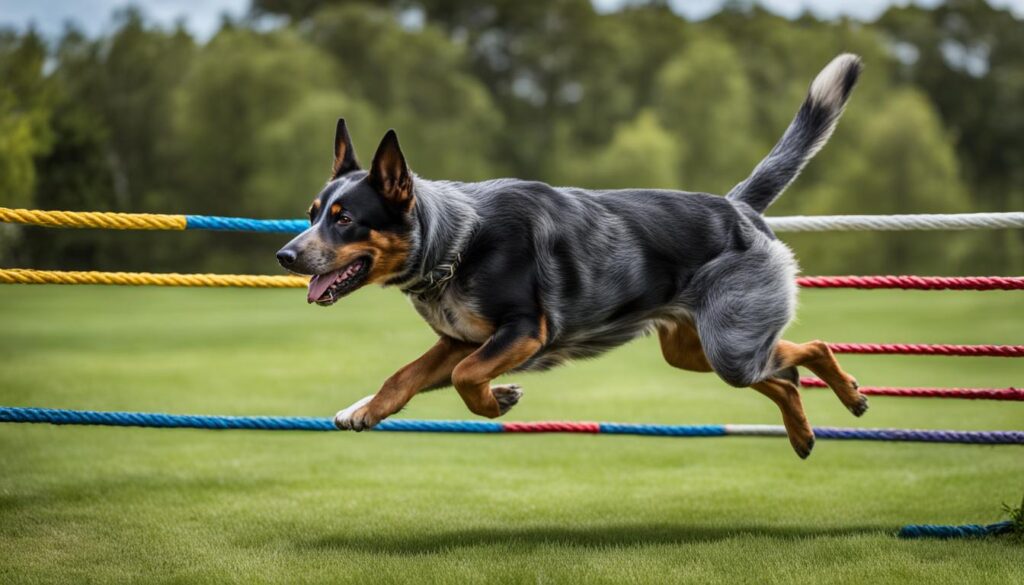Greetings, fellow canine enthusiasts! Today, I’m excited to delve into the fascinating world of the Australian Cattle Dog breed temperament. As a proud owner of this intelligent and energetic breed, I understand the importance of unraveling their unique personality traits for effective training and care. Join me on this enlightening journey as we explore the depths of the Australian Cattle Dog’s temperament and uncover the secrets to a harmonious bond with our furry friends.
Key Takeaways:
- Understanding the temperament of the Australian Cattle Dog is crucial for their training and care.
- The breed is known for its loyalty, intelligence, and herding instincts.
- Socialization and training are vital to ensure appropriate behavior.
- Basic obedience training forms the foundation for advanced training activities.
- Australian Cattle Dogs have high energy levels and need ample exercise and mental stimulation.
Understanding the Australian Cattle Dog Personality and Behavior
The Australian Cattle Dog, also known as the Blue Heeler, possesses a distinct personality and behavior traits that make them truly unique. With their unwavering loyalty, exceptional intelligence, and innate herding instincts, these dogs are truly one of a kind.
When it comes to their personality, Australian Cattle Dogs are known for their unwavering loyalty and devotion to their owners. They form strong bonds and are highly protective, making them an excellent choice for families looking for a watchful companion. However, this loyalty can sometimes translate into caution around strangers, as they tend to be reserved and wary until they have earned their trust.
Alongside their loyalty, Australian Cattle Dogs are highly intelligent creatures. They thrive on mental stimulation and require plenty of activities to keep their minds engaged. Their intelligence also makes them quick learners, which is why consistent training is crucial. Without proper training and mental stimulation, they can become bored, leading to unwanted behavior such as excessive barking or destructive tendencies.
Herding Instincts and Behavior
One of the most remarkable traits of Australian Cattle Dogs is their innate herding instincts. Bred to work alongside ranchers and farmers, these dogs have a natural instinct to control and move livestock. While this herding instinct can be an advantage, it can also manifest in nipping or attempting to herd people and other animals. It’s important to redirect this behavior through appropriate outlets, such as herding toys and games, to ensure they exhibit appropriate behavior.
Training the Australian Cattle Dog: Basic Obedience
When it comes to training an Australian Cattle Dog, basic obedience is crucial. These intelligent and energetic dogs thrive on mental stimulation and require clear boundaries to ensure they develop into well-behaved companions. Teaching commands such as sit, stay, heel, and come forms the foundation for further training.
Positive reinforcement techniques are highly effective when working with Australian Cattle Dogs. This breed responds well to rewards like treats and praise, which help reinforce desired behaviors. It’s important to be patient and consistent during training sessions, as these dogs are known for their independent nature.
Regular training sessions are necessary to keep their minds engaged and prevent boredom. Australian Cattle Dogs are fast learners and enjoy challenges, so incorporating new commands and tricks into the training routine is beneficial. Additionally, incorporating playtime and socialization with other dogs can help enhance their obedience skills and overall behavior.
Addressing the Herding Instinct in Australian Cattle Dogs
Australian Cattle Dogs are renowned for their strong herding instinct. This natural behavior can sometimes manifest as nipping or attempting to herd people and animals. While it is an innate characteristic of the breed, it is important to redirect this behavior in a positive and controlled manner.
One effective way to address the herding instinct in Australian Cattle Dogs is by providing them with appropriate outlets. Engaging them in activities that simulate herding, such as playing with herding toys or participating in structured herding games, can give them a healthy and constructive way to express their instinct. These activities not only help satisfy their natural drive but also provide mental stimulation, which is crucial for the overall well-being of these intelligent dogs.
Additionally, implementing consistent training and socialization is vital in managing the herding instinct. Teaching commands like “leave it” or “stay” can help redirect their focus away from nipping or herding behaviors. It is also important to expose them to various environments, people, and animals from an early age to enhance their social skills and prevent any anxious or reactive behavior.
Remember, understanding and addressing the herding instinct in Australian Cattle Dogs is essential for their overall happiness and harmonious coexistence with other pets and family members. With proper training, ample mental stimulation, and appropriate outlets for their instinct, these dogs can thrive in a balanced and fulfilling life.
Redirecting the Herding Instinct:
Redirecting the herding instinct in Australian Cattle Dogs is crucial for ensuring positive and appropriate behavior. Here are some effective strategies:
- Provide herding toys or participate in structured herding games to give them a constructive outlet for their instinct.
- Teach commands like “leave it” or “stay” to redirect their focus away from nipping or herding behaviors.
- Expose them to different environments, people, and animals from an early age to enhance their social skills and prevent anxious or reactive behavior.
By implementing these strategies, you can effectively manage the herding instinct in Australian Cattle Dogs and create a harmonious living environment for both your dog and your family.
Exercise and Mental Stimulation for Australian Cattle Dogs
Australian Cattle Dogs are known for their high energy levels, and it’s important to provide them with plenty of exercise to keep them happy and healthy. Regular physical activity helps to release their pent-up energy and prevents behavioral problems that can arise from boredom.
Some great exercise options for Australian Cattle Dogs include activities that allow them to use their natural herding instincts, such as playing fetch or engaging in agility training. These activities not only provide physical exercise but also mental stimulation, which is equally important for this intelligent breed.
In addition to physical exercise, mental stimulation is crucial for Australian Cattle Dogs. They thrive on tasks that challenge their problem-solving abilities and keep their minds engaged. One way to provide mental stimulation is through puzzle toys or interactive games that require them to figure out how to obtain a reward.
Another effective method is scent work, which taps into their exceptional sense of smell. Hide treats or toys around the house or yard and encourage your Australian Cattle Dog to find them using their nose. This activity not only provides mental stimulation but also strengthens the bond between you and your dog.
Keeping Your Australian Cattle Dog Engaged
It’s important to provide a variety of activities to keep your Australian Cattle Dog engaged and mentally stimulated. Mix up their exercise routine by introducing new games or challenges. This variety prevents them from getting bored and helps prevent destructive behaviors that can result from pent-up energy.
Additionally, consider enrolling your Australian Cattle Dog in group training classes or dog sports. These activities not only provide mental stimulation but also allow your dog to socialize with other dogs and learn new skills.
Remember, a tired Australian Cattle Dog is a happy Australian Cattle Dog. By incorporating regular exercise and mental stimulation into their daily routine, you can ensure that your dog remains healthy, happy, and well-behaved.

Advanced Training Techniques for Australian Cattle Dogs
When it comes to training Australian Cattle Dogs, the possibilities are endless. Once your dog has mastered basic obedience, it’s time to unlock their full potential with advanced training techniques. These intelligent and driven dogs thrive on mental and physical challenges, making them perfect candidates for activities like agility training.
The Benefits of Agility Training
Agility training provides numerous benefits for Australian Cattle Dogs. This high-energy breed loves to run, jump, and navigate obstacles with precision and speed. Not only does agility training keep them physically fit, but it also helps develop their coordination, focus, and problem-solving skills.
With the guidance of a knowledgeable trainer, you can introduce your Australian Cattle Dog to a variety of agility equipment, such as tunnels, hurdles, and weave poles. Through positive reinforcement and practice, they will learn to maneuver through the course, following your commands and cues.
Taking It to the Next Level
Agility training is just the beginning of advanced training for Australian Cattle Dogs. These intelligent canines excel in various activities like scent tracking, obedience trials, and even competitive sports like flyball or disc dog competitions.
By continuously challenging your Australian Cattle Dog with new tasks and games, you can keep their minds sharp and prevent boredom. This ongoing training not only strengthens the bond between you and your furry friend but also ensures that they remain mentally stimulated and well-behaved.
Consistency and Behavioral Concerns in Australian Cattle Dogs
Consistency plays a crucial role in the training of Australian Cattle Dogs. These intelligent and energetic breeds thrive on routine and clear expectations. By maintaining a consistent training approach, you will establish a strong foundation for your dog’s behavior. Consistency involves using the same commands, reinforcement techniques, and expectations in every training session.
When it comes to addressing behavioral concerns in Australian Cattle Dogs, it is important to approach them with understanding and patience. Some common concerns include excessive barking, separation anxiety, and aggression. It is crucial to identify the underlying cause of the behavior and address it accordingly. Seeking the assistance of a professional dog trainer or behaviorist can be beneficial in managing and modifying problematic behaviors.
H3: Creating a Structured Training Routine
One way to ensure consistency in training is by creating a structured routine. Establish a regular schedule for feeding, exercise, and training sessions. This will provide your Australian Cattle Dog with a sense of predictability and help them understand what is expected of them. Consistency in your daily interactions and responses to their behavior is also key to maintaining a balanced and well-behaved dog.
In conclusion, consistency is vital for effective training and behavior management in Australian Cattle Dogs. By establishing clear boundaries, maintaining a structured routine, and addressing any behavioral concerns promptly, you will set your dog up for success. Remember to approach their training with patience, positivity, and an understanding of their unique temperament.
Continued Learning and Adaptation for Australian Cattle Dogs
The journey of training and caring for an Australian Cattle Dog is a continuous process that extends beyond basic obedience. As our beloved furry companions grow and change, it is essential to provide them with ongoing mental stimulation and adapt our training techniques to their evolving needs. Continued learning is key to building a strong bond and maintaining a harmonious relationship with our Australian Cattle Dogs.
One crucial aspect of continued learning is to challenge our Australian Cattle Dogs with new games and tricks. These activities not only keep their minds sharp but also provide an outlet for their high energy levels. Engaging them in activities such as puzzle toys, hide-and-seek, and interactive games can help prevent boredom and promote mental stimulation.
Adaptation is another important factor in the training journey with Australian Cattle Dogs. Life circumstances may change, whether it’s moving to a new home or introducing new family members or pets. In these situations, taking the time to revisit basic training and socialization techniques can ensure a smooth transition for our furry friends. Providing consistent boundaries, positive reinforcement, and patience during these times of change will help our Australian Cattle Dogs adjust and thrive.
As responsible dog owners, it is crucial to stay updated on the latest training techniques and research in canine behavior. Attending training workshops, reading books, and consulting with professional trainers can provide us with valuable insights and tools to enhance our training skills. By remaining open to new information, we can continue to refine our training methods and adapt them to suit the unique needs of our Australian Cattle Dogs.

The Importance of Health Check-ups for Australian Cattle Dogs
As a responsible owner of an Australian Cattle Dog, regular health check-ups should be a top priority. These check-ups are crucial for ensuring the overall well-being and longevity of your beloved pet. By scheduling routine visits to the vet, you can catch any potential health issues early on, allowing for prompt treatment and prevention of more serious complications.
During health check-ups, the vet will conduct a thorough examination of your Australian Cattle Dog, assessing their weight, body condition, and overall physical health. They may also perform diagnostic tests, such as blood work and urine analysis, to detect any underlying health conditions that may not be immediately apparent. Additionally, vaccinations and preventative measures for parasites, such as fleas and ticks, can be administered during these visits to safeguard your dog’s health.
Aside from addressing any existing health concerns, health check-ups also provide an opportunity for you to discuss any changes in your dog’s behavior or general well-being with the vet. They can offer valuable advice on diet, exercise, and other aspects of care specific to Australian Cattle Dogs to ensure they stay in optimal health. Remember, prevention is always better than cure, and regular vet visits play a crucial role in maintaining your Australian Cattle Dog’s overall wellness.
Keep Your Australian Cattle Dog Healthy with Regular Vet Visits
To summarize, regular health check-ups are essential for the well-being of your Australian Cattle Dog. They allow for early detection and treatment of any potential health issues, provide preventative care against parasites, and offer guidance on maintaining your dog’s overall health. By making vet visits a priority, you can ensure that your Australian Cattle Dog remains happy, healthy, and by your side for years to come.
Adapting Training to Changing Life Circumstances
Life circumstances can change, and as a responsible Australian Cattle Dog owner, I understand the importance of adapting my training techniques accordingly. Whether it’s moving homes or introducing new family members, taking the time to ensure a smooth transition is crucial for the well-being of my beloved pet.
One aspect that requires special attention is introducing new pets into the household. It is essential to carefully manage the initial interactions between my Australian Cattle Dog and the new pet. By supervising their interactions and gradually increasing their exposure to each other, I can help foster a positive relationship and minimize any potential conflicts.
In addition to introducing new pets, changes in living environments can also impact my Australian Cattle Dog’s behavior and training needs. Moving to a new home may introduce unfamiliar surroundings, different noises, and potential stressors. To help my dog adjust, I provide a secure and comfortable space within the new home and gradually introduce them to the new environment, using positive reinforcement to build their confidence.
Adapting my training approach to changing life circumstances
When faced with changes in my life circumstances, I understand the importance of revisiting basic training techniques. By reinforcing obedience commands and continuing to reinforce positive behaviors, I can help my Australian Cattle Dog navigate through these transitions smoothly.
Consistency plays a vital role in adapting training to changing life circumstances. Although changes can be challenging, I ensure that the rules and expectations remain consistent to provide a sense of stability for my dog. This includes maintaining established routines and providing ample mental and physical stimulation to help alleviate any potential stress or anxiety.
Adapting my training approach to changing life circumstances is an ongoing process. By remaining flexible, patient, and attentive to my Australian Cattle Dog’s needs, I can successfully navigate through transitions and provide the support necessary for their continued well-being.
Conclusion
The Australian Cattle Dog is an incredible breed that requires proper care and training to thrive. With their intelligence and energy, it’s important to provide consistent training and mental stimulation to keep them happy and fulfilled.
By following the tips and guidelines outlined in this comprehensive care guide, you can ensure that your Australian Cattle Dog leads a healthy and well-balanced life. Remember to establish clear boundaries and expectations through positive reinforcement techniques, such as treats and praise, to foster a strong bond between you and your dog.
When it comes to training, it’s crucial to be patient and understanding. Australian Cattle Dogs have a unique temperament that requires a firm yet gentle approach. Socialization is key to helping them navigate their interactions with other dogs and strangers, ensuring they are well-adjusted and confident.
With the right care and training, your Australian Cattle Dog will become your devoted companion and an exemplary member of your family. Invest time and effort into their well-being, and you’ll reap the rewards of a harmonious and loving relationship for years to come.
FAQ
What is the temperament of an Australian Cattle Dog?
The Australian Cattle Dog is known for its loyalty, intelligence, and herding instincts. They can be protective of their owners and cautious around strangers.
What kind of training does an Australian Cattle Dog need?
Basic obedience training is essential for every Australian Cattle Dog. Teaching commands like sit, stay, heel, and come forms the foundation for further training.
How do you address the herding instinct in Australian Cattle Dogs?
It is important to redirect their herding behavior and provide appropriate outlets, such as herding toys and games.
How much exercise do Australian Cattle Dogs need?
Australian Cattle Dogs have high energy levels and require plenty of exercise. Activities like fetch, agility training, and long walks are beneficial for their overall well-being.
Can Australian Cattle Dogs excel in advanced training activities?
Yes, once basic obedience is mastered, Australian Cattle Dogs can excel in advanced training activities like agility training and scent tracking.
How do you address behavioral concerns in Australian Cattle Dogs?
Consistency is key when training Australian Cattle Dogs. Clear boundaries and addressing behavioral concerns promptly and with understanding is important.
Is training for Australian Cattle Dogs an ongoing process?
Yes, training for Australian Cattle Dogs is an ongoing process. Challenging them with new games and tricks and staying updated on training techniques is crucial.
How important are regular vet check-ups for Australian Cattle Dogs?
Regular vet check-ups are essential for the overall health of Australian Cattle Dogs. It allows for early detection of potential health issues.
How do you adapt training to changing life circumstances?
When life circumstances change, it is important to adapt training techniques accordingly. Taking the time to ensure a smooth transition and revisiting basic training and socialization techniques is crucial.



